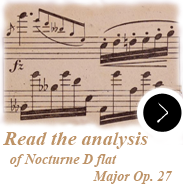Annotations that comment on particular problematic places in the text are marked with coloured dots. Notes that cover topics of fundamental importance for the establishment of the text are indicated with larger disks, and the biggest marks are reserved for places where text variants occurring in the sources may significantly influence the musical shape of a given fragment.
The colour-coded categories signal the scope and type of editorial issues connected with the topic addressed in a given note. And thus:
 Graphic ambiguities – in places marked with red dots at least one of the sources contains an element of notation that is incorrectly written and therefore ambiguous. In most cases this relates to manuscripts and various interpretation marks of uncertain placement, e.g. slurs that begin or end in places not graphically connected with any note, or dynamic hairpins with arms of visibly different length. Notes of uncertain pitch occur much more seldom. Illegible handwriting in a teaching copy would also be treated as a graphic ambiguity.
Graphic ambiguities – in places marked with red dots at least one of the sources contains an element of notation that is incorrectly written and therefore ambiguous. In most cases this relates to manuscripts and various interpretation marks of uncertain placement, e.g. slurs that begin or end in places not graphically connected with any note, or dynamic hairpins with arms of visibly different length. Notes of uncertain pitch occur much more seldom. Illegible handwriting in a teaching copy would also be treated as a graphic ambiguity. Interpretations within context – this category applies when the notation of a source is unambiguous, yet obviously or probably mistaken. Evident errors are most often connected with omitted accidentals or rhythm.
Interpretations within context – this category applies when the notation of a source is unambiguous, yet obviously or probably mistaken. Evident errors are most often connected with omitted accidentals or rhythm. Differences between sources – these are perhaps the most frequent situations that call for the editors’ attention, yet by no means the most difficult ones; in most instances , those differences result from copying or engraving errors that are fairly easy to explain.
Differences between sources – these are perhaps the most frequent situations that call for the editors’ attention, yet by no means the most difficult ones; in most instances , those differences result from copying or engraving errors that are fairly easy to explain. Editorial adjustments identify places in which alterations, mainly additions to the main text or texts of particular sources, were made by the editors of mUltimate Chopin.
Editorial adjustments identify places in which alterations, mainly additions to the main text or texts of particular sources, were made by the editors of mUltimate Chopin. Corrections and alterations – this category applies to places where Chopin himself introduced changes. These may be e.g. corrections made in the autograph or one of the editions, or other situations when definitely or probably authentic versions of sources differ between one another.
Corrections and alterations – this category applies to places where Chopin himself introduced changes. These may be e.g. corrections made in the autograph or one of the editions, or other situations when definitely or probably authentic versions of sources differ between one another. Source and stylistic information – this category contains various information related to characteristic features of particular sources and groups of sources, and also examples of Chopin’s typical melodic and harmonic devices.
Source and stylistic information – this category contains various information related to characteristic features of particular sources and groups of sources, and also examples of Chopin’s typical melodic and harmonic devices.
The first four categories listed above correspond to the subsequent stages of editorial work undertaken with the aim to establish the text that would reflect Chopin’s intentions. The fifth category is a documentation of Chopin’s creative process and the sixth deals with certain features of his style and typical situations related to the sources.
It happens very often that one note fits into several different categories. In such cases it is marked with the colour of the category that has the lowest number on the above list.

